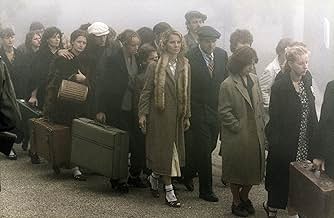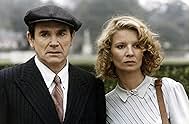Les uns et les autres
- 1981
- 3h 4min
NOTE IMDb
7,3/10
2,9 k
MA NOTE
Ajouter une intrigue dans votre langueThe intertwined lives of three generations of musicians and dancers from Russia, Germany, France and the U.S., from before World War II through the war and the Holocaust, to the 1980s.The intertwined lives of three generations of musicians and dancers from Russia, Germany, France and the U.S., from before World War II through the war and the Holocaust, to the 1980s.The intertwined lives of three generations of musicians and dancers from Russia, Germany, France and the U.S., from before World War II through the war and the Holocaust, to the 1980s.
- Réalisation
- Scénario
- Casting principal
- Récompenses
- 1 victoire et 6 nominations au total
Avis à la une
I saw this film when it first came out in Paris. It was a great experience! An epic sweep, not unlike *Gone With the Wind* or *Children of Paradise*. But the American release, titled *Bolero*, had about 20-30 minutes cut from it and it was a disjointed mess. Small wonder it bombed here. The video release is of the American version. If at all possible, try to see the original, 3 hour release.
I was in Strasbourg, France in 1981 when this film first came out and saw it in a movie theater. It was a compelling film and spoken not only in French, but German, Russian and English, according to the character's language. I loved the story, the music (my favorite rendition of Bolero), the incredible dancing, the acting. I even acquired the soundtrack and a VHS of the movie after seeing it, even though I don't typically acquire copies of movies once I have seen them. This film is and will always be my favorite film of all time. I happened to be studying the subject of international human rights law in Strasbourg at the time, so it seemed fitting to see this movie about WWII and the humanitarian aspects of the finale of the film. Our world has become so interdependent that other directors should take note of this little-known film and its use of multiple languages to great effect.
10ericibe
I may not remember everything, but this film has been on my mind since I saw it 23 years ago. I was in high school in a small town in Iowa. One of our band directors had a large collection of film on tape and laser disc. He would have movie parties for kids he taught. I showed an interest in film and he would screen some films I would have otherwise never have seen. I remember watching Bolero. (I do not think I knew it was known by any other name) I was in absolute awe of this film. The music, the story, the pacing - everything you couldn't get from popular American films.
I have avoided seeing it again in the intervening time because I did not want my more grown up sensibilities to have a different opinion of the film. After reading some of the comments here I can feel safe to view it again.
I have avoided seeing it again in the intervening time because I did not want my more grown up sensibilities to have a different opinion of the film. After reading some of the comments here I can feel safe to view it again.
First thing to bear in mind is that like Hossein's "les Miserables" or Enrico's "Au Nom de Tous les Miens",the movie which was theatrically released is a digest of a miniseries ,the running time of which exceeded six hours.In three hours,there are too many characters ,and Lelouch uses the same thespians to portray the parents and the children (Chaplin,Caan,Bouix...)which sometimes is a mess.But it's Hossein who gets the biscuit:even "made look younger" ,he was 54 at the time and it's impossible to believe he is a soldier coming back from the Algeria war.
It can be looked upon as a musical ,but the only musical sequence which is really awesome is Ravel's bolero where the four (French,Russian,German and American) families prove us (as if we did not understand) that it's better making music than making war.Thank you and God bless you all.
That said ,there's that optimistic bourgeois side in Lelouch's movies;it's so glaring here that it becomes sometimes unbearable.With a few exceptions (Garcia's husband,the girl who used to play around with the Germans,victims of war),it's a success story.We deal with educated brilliant people whose career will take them to megastardom after the war.There's a French film made up of sketches called "Retour à la vie" which depicted the fates of four men and a woman after WW2.Their future was not so bright: the concentration camps ,it's not a thing you forget overnight.You are going to say,Nicole Garcia ends up in an insane asylum.Probably but long after the war.In "Retour à la vie" Aunt Anna was so weak and so traumatized she could not utter one word.
The cast is admittedly impressive.But if the leads were not played by celebrities such as James Caan,Geraldine Chaplin or Fanny Ardant,we would be lost in a terrible mess.Ansd sometimes I must confess I do not know if it's the father (mother) or the son (daughter).And Lelouch spared us the third generation (they are still brats).To think that the last part of "Toute une Vie" (1974) another extravaganza which spanned a century,the last part was pure sci-fi and took us down to the future world! Les uns will like.Les autres won't.
It can be looked upon as a musical ,but the only musical sequence which is really awesome is Ravel's bolero where the four (French,Russian,German and American) families prove us (as if we did not understand) that it's better making music than making war.Thank you and God bless you all.
That said ,there's that optimistic bourgeois side in Lelouch's movies;it's so glaring here that it becomes sometimes unbearable.With a few exceptions (Garcia's husband,the girl who used to play around with the Germans,victims of war),it's a success story.We deal with educated brilliant people whose career will take them to megastardom after the war.There's a French film made up of sketches called "Retour à la vie" which depicted the fates of four men and a woman after WW2.Their future was not so bright: the concentration camps ,it's not a thing you forget overnight.You are going to say,Nicole Garcia ends up in an insane asylum.Probably but long after the war.In "Retour à la vie" Aunt Anna was so weak and so traumatized she could not utter one word.
The cast is admittedly impressive.But if the leads were not played by celebrities such as James Caan,Geraldine Chaplin or Fanny Ardant,we would be lost in a terrible mess.Ansd sometimes I must confess I do not know if it's the father (mother) or the son (daughter).And Lelouch spared us the third generation (they are still brats).To think that the last part of "Toute une Vie" (1974) another extravaganza which spanned a century,the last part was pure sci-fi and took us down to the future world! Les uns will like.Les autres won't.
Just viewed this movie on a DVD from Netflix. This movie is what a motion picture can be in the hands of an intelligent and talented director.
The photography was wonderful, the use of color was spectacular, the sound was excellent, and the music and performances were top notch. I especially liked the full symphony orchestra segments and the American big band segments. The Folies-type musical numbers were also done with flair, and Geraldine Chaplin proved herself to be a classy cabaret singer (assuming her voice wasn't dubbed). Michel Legrand I believe was responsible for the music, which was first rate throughout.
All production values were of the highest order.
The final dance sequence, which lasted far longer than anything Hollywood would permit, was phenomenal; the late Jorge Donn was not Nureyev, but spectacular all the same. The robustness and uncompromisingly balletic style of the finale put the ballet sequences in a couple of American movies--American In Paris and Carousel-- in the shade.
Released in the U.S. as Bolero, apparently. Without car chases, explosions, etc., I doubt if it did very well at the box office over here.
The photography was wonderful, the use of color was spectacular, the sound was excellent, and the music and performances were top notch. I especially liked the full symphony orchestra segments and the American big band segments. The Folies-type musical numbers were also done with flair, and Geraldine Chaplin proved herself to be a classy cabaret singer (assuming her voice wasn't dubbed). Michel Legrand I believe was responsible for the music, which was first rate throughout.
All production values were of the highest order.
The final dance sequence, which lasted far longer than anything Hollywood would permit, was phenomenal; the late Jorge Donn was not Nureyev, but spectacular all the same. The robustness and uncompromisingly balletic style of the finale put the ballet sequences in a couple of American movies--American In Paris and Carousel-- in the shade.
Released in the U.S. as Bolero, apparently. Without car chases, explosions, etc., I doubt if it did very well at the box office over here.
Le saviez-vous
- AnecdotesFrancis Lai: The composer appears as the blind accordion player.
- Gaffes(at around 1h 21 mins) The soldiers are playing cards on the train and the game they are playing changes between shots.
- Crédits fousThe grand majority of the opening credits are spoken by the narrator. The narrator stops after crediting the choreographer. Only the film's production company, title and the name Claude Lelouch appear in writing before the Bolero dance at the opening (when the writing is onscreen, the orchestra is warming up). Also, a quote by Willa Cather appears at the very beginning.
- Versions alternativesPresented on French television in a 6 hours version quite clearer then the shortened American release. Richard Bohringer and Fanny Ardant's characters, for example, are better developed.
- ConnexionsEdited into Les uns et les autres (1981)
- Bandes originalesFolies Bergère
Music by Francis Lai
Lyrics by Boris Bergman
Performed by Catherine Russell and Ginette Garcin
Meilleurs choix
Connectez-vous pour évaluer et suivre la liste de favoris afin de recevoir des recommandations personnalisées
- How long is Bolero?Alimenté par Alexa
Détails
- Date de sortie
- Pays d’origine
- Sites officiels
- Langues
- Aussi connu sous le nom de
- Bolero
- Lieux de tournage
- Garancières, Yvelines, France(Railway crossing and station scene)
- Sociétés de production
- Voir plus de crédits d'entreprise sur IMDbPro
- Durée
- 3h 4min(184 min)
- Couleur
- Rapport de forme
- 2.35 : 1
Contribuer à cette page
Suggérer une modification ou ajouter du contenu manquant




















